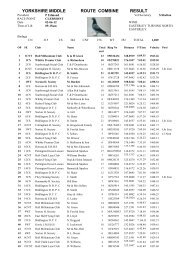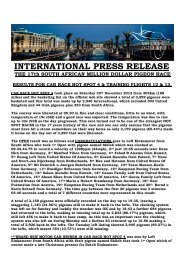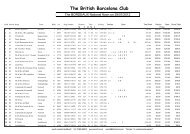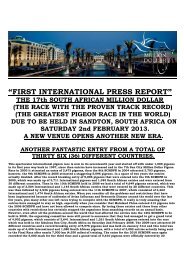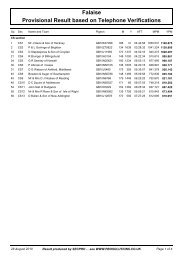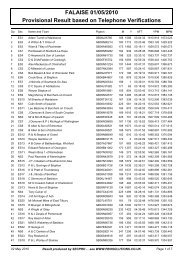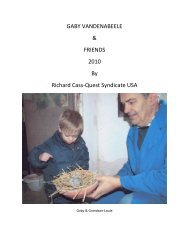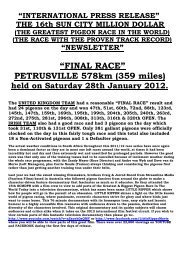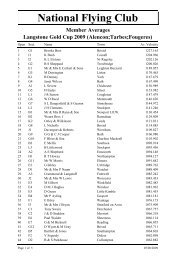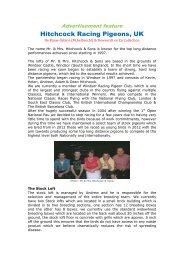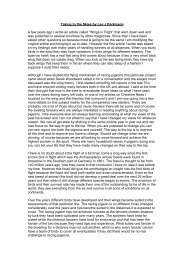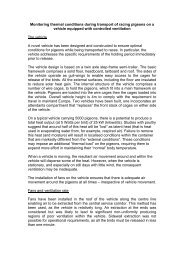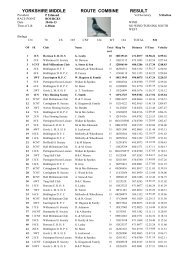February - Elimar Pigeon Services
February - Elimar Pigeon Services
February - Elimar Pigeon Services
Create successful ePaper yourself
Turn your PDF publications into a flip-book with our unique Google optimized e-Paper software.
MONTH BY MONTH<br />
with Chris<br />
Champion “Tracey’s Red” winner of the N.W.C.C.<br />
Hall of Fame and over £5,000 in his racing career,<br />
for Chris Knowles of Woodley, Stockport.<br />
<strong>February</strong> -- month of Februa:<br />
Februarius had 28 days, until circa 450 BC when it had 23 or 24 days on some of every second year, until<br />
Julius Caesar when it had 29 days on every fourth year and 28 days otherwise. Februa is the Roman<br />
festival of purification, held on <strong>February</strong> fifteenth. And so we have the <strong>February</strong> that we know today with<br />
possibly the best known date of the calendar month being the 14th day, on which we recognise St.<br />
Valentine and a date on which many many fanciers in decades passed, have chosen on which to pair their<br />
pigeons.<br />
Blackpool was once again a good show in most aspects, the fancy pigeon section up in the Spanish Hall<br />
was very popular again and looking at the class winners in the main show, it was great to see dark<br />
chequers taking major honours when in recent times domination seems to have been with more modern<br />
colours like the Opals. Once again Norman Perry had a great show winning the Supreme Champion Class<br />
as did Mr. & Mrs. Ron McCarthy taking BIS & BOS. If the BHW got one thing wrong this year, in my<br />
opinion it was narrowing the aisles in the main show hall to fit in the racing classes. Not only did it make<br />
moving around the pens difficult but as anyone who was there at three o’clock Sunday will tell you, it made<br />
unpenning even more difficult. The only consolation being that competitors were allowed to get their<br />
baskets that bit earlier than in past years.
Generally speaking nowadays, <strong>February</strong> is the month that most fanciers use as final preparation prior to<br />
the O.B. race season and the month in which many youngsters bound for a season of racing on the<br />
darkness system are weaned off and made ready for the challenge to come. My first youngsters hatched<br />
on the 28th Jan. from the stock birds and the racers are now sitting tightly and on course for their pre race<br />
preparations. Monday 2nd Feb. Has seen snows and freezing conditions sweep across the country and as<br />
usual when the snows strike, the cross Pennine Roads are hit badly and the first to go near me was Snake<br />
Pass in both directions between Glossop and Sheffield. Despite the sometimes gale like conditions the<br />
pigeons were still in the aviaries with their wings up and making the most of it! By the time Feb. 14th<br />
arrives, the sun will rise in my part of the world at around 07.25 a.m. and set at around 17.20 p.m. Which is<br />
round about 9,8 hours of light and things are beginning to look up for the wild birds.<br />
These pictures taken early <strong>February</strong>, shows the<br />
access that the yearlings have to the aviary<br />
cages throughout their coupling cycle and leading<br />
up to the point where they begin exercise once<br />
again. As you can see from the pictures, this<br />
gives good sunlight when open and is closed<br />
down each evening to shut out the wind, rain and<br />
snow just lately. When closed down from about<br />
16.30 p.m. the temperature inside the loft is<br />
better for the pigeons as any draught is excluded<br />
and the humidity can be controlled. When<br />
necessary I have radiant heaters to put on, which<br />
are thermostat and hygrostat controlled.<br />
The hen on the left is in the sun as she sits her<br />
eggs.<br />
The one thing that I find most advantageous about having large aviary cage trapping systems, is the<br />
flexibility that they give me to provide my birds with regular baths at the time of year that they need them<br />
most and are not going out to exercise. This means that they can have ample access to bathing and<br />
sunshine whilst there is a zero risk to hawks. It is also ideal for my show racers which never fly out and<br />
you can see below, their condition is first class.<br />
The Sun Rise & Sun Set times for <strong>February</strong> 2009 in my area.<br />
Day RiseTime SetTime Length Of Day<br />
1/2/2009 7.859 16.940 9.081Hrs<br />
7/2/2009 7.688 17.129 9.441Hrs<br />
14/2/2009 7.467 17.352 9.884Hrs<br />
21/2/2009 7.229 17.572 10.343Hrs<br />
28/2/2009 6.976 17.789 10.813Hrs
American Football fans amongst you will no doubt have been part of the one billion people who have just<br />
watched Superbowl XL111( 43) and the victory for Pitsburgh Steelers, which brought to mind for me the<br />
famous quote from the American Football coach Paul Bryant who said “It's not the will to win, but the<br />
will to prepare to win that makes the difference”. I couldn’t think of a more appropriate quote for the<br />
month of <strong>February</strong>!<br />
Above picture taken on the morning of 5th <strong>February</strong> 2009. The blow up on the right clearly shows a<br />
female Sparrowhawk nicely inconspicuous as she watches the pigeons in my aviaries from her spot in<br />
the trees behind my lofts.<br />
The above photo illustrates graphicaly the dangers from the hawk at this time of the season and why I<br />
believe so strongly in confining the pigeons until the odds are more in my favour. On this occasion I was<br />
lucky to have my camera to hand and was alerted to the hawks presence in the area by scattering street<br />
pigeons, all too often the only way you can know, that they have visited, is the tell tale signs of stripped<br />
feathers from a blackbird, sparrow or collared dove, usually lying some place near to the foot of one of the<br />
hedges!<br />
Despite the distraction of the hawk, I ensured that I completed my task for the day which, was to compile a<br />
list of what nestboxes had youngsters to be rung on what day. I do this every season and use my first<br />
hatching as the base to calculate against. This year it was youngsters being rung on 4th <strong>February</strong> from 1st<br />
eggs laid on 11th Jan that I have based forecast ringing dates for all other pairs. It is not always 100%<br />
accurate but I never miss ringing and it gives me an idea of how well each pair is feeding against the<br />
benchmark. I also use this chart if I experiment with feeding something new to breeders in a specific<br />
section which, I do from time to time as a trial to see if it aids YB development. I know that record keeping<br />
is not for everyone but I can honestly say that it has he;lped me considerably over the years and as I get<br />
older, the more I need to write things down!
Weaning Young Birds: Now is the time that I do my preparation for the weaning of my youngsters. This is<br />
something that I have done religiously since I first began to send youngsters to races from France in the<br />
year of their birth. Although I do not believe that we should be sending YBs to such races, at a time of the<br />
year when the daylight hrs. are not sufficient to allow liberations later in the morning when temperatures<br />
are suitable for 300 plus races, I do enjoy the challenge that they bring. My first step towards this, is to<br />
ensure that babies are weaned into baskets from the nest pan, so that they learn to eat and drink from the<br />
word go. I will take some photos and include them in the March article to show how I set this up. I am not<br />
saying that it makes the YBs win these races but it has helped me to time in many times when good<br />
fanciers have failed to get a bird on the day. I know that it is not the only contributory factor but for me, I<br />
believe it to be MAJOR. The preparation is the cleaning and disinfecting of the weaning crates so that they<br />
have ample time to dry out, at a time of the year when good drying days are sparse. The crates have a<br />
layer of about one inch of wood chips (Horse Bedding) with a small trough inside for food and an external<br />
trough for water. They are then fed and watered twice per day for one week before going into the race<br />
section when they are darkened from day 1. No youngster has it’s head dipped and any deterioration by<br />
the end of the week and a youngster would be disposed of. I can honestly say that this has only ever<br />
happened with three or four youngsters since 1992.<br />
The weaning of the youngsters is then followed by vaccination which I do when I have my full race team<br />
weaned into their race section. I think that the earlier the youngsters are vaccinated, the better and<br />
especially before they begin flying out. I 1991 when flying in partnership as Hulme and Knowles, the Ybs<br />
were left during the day and were not being vaccinated until May/June. The result was a confirmed case of<br />
paramyxo in the YBs and what followed was a night mare. It served as a very good lesson and I learned a<br />
great deal from the experience but I do not intend to repeat that naive mistake. As things transpired, once<br />
the all clear was received, we went on to win 1st Section NFC Bordeaux 598 miles and 2nd Section NFC<br />
Pau 700 miles with another 3 pigeons in the first 25 of the Section result. So as you can see it did not<br />
affect the OBs but the YBs did not race, a No. had to be killed and I never had any faith in the YBs born<br />
that year other than the summer bred youngsters that followed.<br />
Dehydration: The whole point of basket training the YBs at the point of weaning and the repeat refresher<br />
training from baskets, is to prevent or at least the the youngster the best chance of avoiding dehydration<br />
during transit. I also believe that the refresher training for old birds is worth while at the early stages of<br />
each season. I will include a photo of how I do this in the March article. There is also one more point to<br />
make on the subject of dehydration, which I meant to cover earlier and that is the care of stock birds when<br />
feeding youngsters of around seven to fourteen days old. Obviously with the transition from feeding soft<br />
milk to hard corn, the parent bird has to use water as it’s transport agent for the feeding. During this time I<br />
like to supplement the parent birds with an additive in their water for five or six days. The additive is a<br />
combination of electrolytes with vitamins, trace elements and amino acids. Given at the rate of two<br />
tablespoons per litre of water, the benefits in the growth of the youngsters and the health of the parents is<br />
very noticeable. The product that I favour most id Belgasol from De Weerd in Holland but you could use<br />
any similar product or indeed make up your own. The cost doesn’t need to be silly and the benefit is<br />
significant.<br />
Above sketch and photos are the actual skeleton of a racing pigeon, perhaps not quite as some may imagine.
Beyond the skeleton: Beyond the skeleton is everything that we are working hard at this time of year to<br />
assist. Just having finished helping the pigeons to grow the best set of feathers possible, now we have to<br />
ensure that the essential organs are healthy, the body weight is right and that the muscles are gradually<br />
worked and fine tuned in readiness for the forthcoming training and racing. As you can see from the<br />
skeleton of the pigeon above, the keel or sternam is the one place that is specifically designed to house<br />
the major muscle mass and the strategic position is critical to the aerodynamics of the pigeon in flight.<br />
These muscles that we refer to as the pectoral muscles, need to be prepared sensibly and methodically if<br />
a pigeon is to enjoy a season of real success. Feeding and exercise along with a correct environment are<br />
the key ingredients and although I do not intend to cover such a subject in this article, I do encourage<br />
every fancier to start thinking seriously now about it, if you haven’t already done so. If there is one thing<br />
for certain in this sport nowadays, it is that if you race at the highest levels, you will be racing against<br />
specialists. By this I mean, sprint specialists, middle distance, long distance and young bird specialists as<br />
well as the good old fashioned “all rounders” and if your not preparing methodically you can bet they will<br />
be!<br />
Friends: I would like to think that over the years that I have enjoyed within the pigeon sport, the most<br />
valuable assets that I have obtained are the friends that I have made. In closing this month, I am<br />
dedicating this final passage to a true friend Richie Ryder pictured below, who has spent the last three<br />
Two very good friends, on the left Arthur Cowley and right Richie Ryder, taken at one of Lancashire<br />
Social Circle gatherings.<br />
months or so in hospital, including his Christmas and New Year. Richie has suffered on and off for many<br />
years with lung problems following an industrial accident when employed in the printing industry. As<br />
Secretary of the Lancashire Social Circle he is a tireless worker and has a personality second to none. I<br />
know that I speak for all members of the LSC and indeed all who know him, when I say, “Get well soon<br />
Richie” ! He is the type of fancier and friend that makes this sport worth all the time and effort that we put<br />
into it. I wonder at times without such friends whether the sport would be worth while?<br />
Good friends are like stars.....<br />
You don't always see them,<br />
But you know they are always there.<br />
Until next month, Enjoy your pigeons!<br />
Chris K



